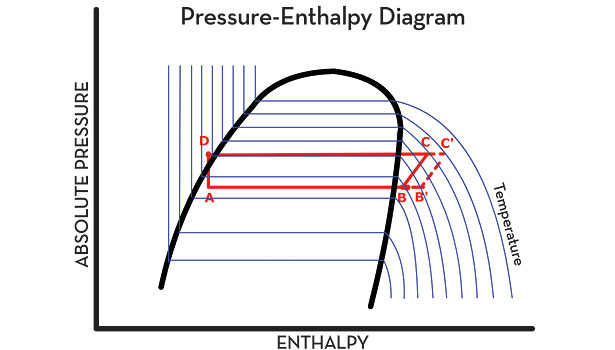
|
| Joe Marchese |
Insulating the suction line is done to prevent condensate from developing and dripping off. This condensate drip can cause water damage to the material under it or cause a slip hazard for people walking below it.
Another very important reason to insulate the suction line, which is sometimes overlooked, is to limit the amount of heat added to the refrigerant as it travels back to the compressor. This additional heat will cause the system to reject unnecessary heat without any benefit. In addition, if too much heat is added it may cause the compressor to run too hot. A well-insulated suction line can save money by reducing both energy consumption and equipment breakdowns.
We can use a pressure-enthalpy (P-H) diagram (see the illustration above) to show how this additional heat affects the operation of a system. Let line AB represent the process of the refrigerant as it travels through the evaporator, with no additional heat added (and assuming no pressure drop). Point B will represent both the condition (temperature and pressure) of the refrigerant leaving the evaporator and entering the compressor. Line BC represents the process through the compressor, with point C representing the refrigerant’s theoretical discharge temperature, and line CD representing the process of the refrigerant through the condenser.
If additional heat is added to the suction line, point B is moved to the right and now becomes B’ and the process through the compressor now becomes B’C’ with C’ being the refrigerant’s new theoretical discharge temperature. The new point C’ is at an elevated temperature and the new longer line C’D now becomes the process through the condenser. Line C’C represents the additional heat needed to be rejected from the condenser.
An Example
Here’s an example: Let’s use a typical system using R-134a and operating at a 20˚F evaporating temperature, a 30° suction line temperature, and a 100° condensing temperature. With no additional heat added to the suction line, our point C would show a theoretical discharge temperature of 125˚ and an enthalpy content of 122.7 Btu/pound.
If the suction line temperature was increased from 30˚ to 60˚ as shown by B’, our new point C’ would represent a theoretical discharge temperature of 145˚, a 16 percent increase. The enthalpy of the refrigerant will have increased from 122.7 Btu/pound to 129.0 Btu/pound, a 7.8 percent increase.
The use of suction line insulation not only prevents water damage and a potential safety hazard, but it also allows the compressor to run cooler and the condenser to have to do less work. So the next time you’re on a job, inspect the condition of the suction line insulation and if damaged or missing, replace it. It will increase the life of the compressor and save your customer money.
Publication date: 9/2/2013
Want more HVAC industry news and information? Join The NEWS on Facebook, Twitter, and LinkedIn today!







